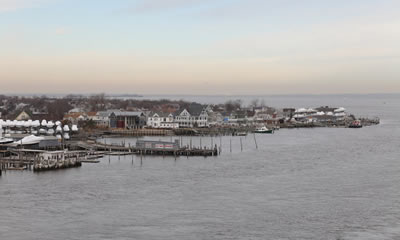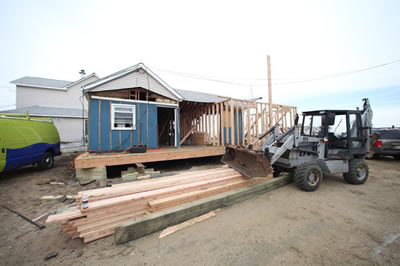
<<<Go Back
|
|
By PETER APPLEBOME
The New York Times
PUBLISHED: 22 February 2013
HIGHLANDS, N.J. — If not for the most deadly natural disaster in American history, in Texas, and an innovative response to it, more than a century ago, one might briskly consign the proposal to save this oft-flooded borough at the northern end of the Jersey Shore to the realm of pigs with wings.
But four months after Hurricane Sandy almost obliterated downtown Highlands, an unlikely idea with one enormous historical antecedent seems to be taking hold here: Don’t just raise the buildings. Raise the town.
After all, officials in the modest, largely working-class community note, something quite similar was done, with the most rudimentary technologies, to save Galveston, Tex., which was raised as much as 17 feet after more than 6,000 people perished in the great hurricane of 1900. Yes, even the proponents here concede, it will be a long shot to persuade the federal government to spend more than $25 million to raise Highlands’s downtown 10 feet as a permanent solution to flooding, storm damage and rising seas.
|
But it is a sign of how high the stakes are — and how uncertain the future for many coastal towns is — that Highlands officials are increasingly focused on one bit of radical surgery from the past and the idea that their best option might be to import perhaps 3.5 million cubic yards of dredged material and elevate the entire downtown, rather than face an eternity of flooded streets and regular disruption.
“Right now, there’s no endgame,” said Frank Nolan, mayor of this community of 5,000 residents where 1,250 of the 1,500 homes and virtually all the businesses were destroyed or badly damaged by the hurricane. “We’re still going to flood. We’re still going to have businesses that are not going to make it.
“We believe the only way to fix this town long-term is to raise the town.”
While other seaside communities face flooding, all of downtown Highlands is in a V Zone, which designates the most flood-prone areas on the preliminary flood-elevation maps being prepared by the Federal Emergency Management Agency. The area is among the lowest elevations on the Jersey Shore, just above sea level. When high tide corresponds with a full moon, it can produce half a foot of flooding even without bad weather.
Officials said the Army Corps of Engineers had looked at the problem for decades. The corps plans to study whether to build a barrier along the waterfront and pump out the water that gets behind that wall. A spokesman for the corps said it recently completed geotechnical borings to move forward with a study for the project with the goal of having a report ready for submission to Congress by the end of next year.
In an e-mail, the corps spokesman said that its current study looked at many alternatives, including nonstructural ones, like buyouts of property, enhanced elevations and flood-proofing, but that those were more costly than the levee, floodwall and road-elevation alternatives being considered.
But local officials said the town flooded from the ground up, so a wall would just allow water to seep in from underneath, filling it like a bathtub. And though raising the buildings is going to be necessary to comply with FEMA’s new flood maps, local officials said that aesthetically and practically it did not make sense to have all of the buildings in town raised as much as 14 feet off the ground — above streets that are still likely to flood.
Instead, they say, raising the elevation of the town itself 8 to 10 feet in stages makes more sense, with buildings lifted first and then fill added underneath.
The idea was suggested, before Hurricane Sandy struck, by Steve Szulecki, the director of the air pollution training program at Rutgers and chairman of the borough’s environmental commission. It was inspired by the fact that Galveston, in a remarkable engineering feat more than a century ago, built a three-mile-long sea wall, raised everything from streetcar tracks to more than 2,000 buildings with hand-turned jackscrews, dredged more than 16 million cubic yards of sand to raise the town and built canals so the sand could be brought to quarter-mile-square sections of the city at a time.
Professor Szulecki estimated that dredging the bay and using the fill to raise Highlands by 8 to 10 feet would cost about $25 million to $30 million, not including infrastructure work or raising homes and buildings. He said that because of Highlands’s low elevation, its compact downtown — roughly 1,500 feet at its widest and just over a mile long — and the terrain’s quick rise to steep cliffs (hence the town name) that limit the flooding geographically, raising the town could work in Highlands in ways that are not appropriate elsewhere.
Professor Szulecki said he had vacillated between thinking that his proposal is hopeless and thinking that “if people keep it in their minds long enough to get past the craziness of it, they can see maybe this isn’t insurmountable after all.”
Still, he said, here and elsewhere, people are trying to adjust to the new post-hurricane realities. “Everyone is trying to catch up to what has occurred,” he said, “and no one is sure how to do it.”
Of course, without support from the Corps of Engineers, the project will go nowhere. In an era of tight budgets, allocating at least $25 million to raise one town will not be easy.
In neighboring Sea Bright, Mayor Dina Long said her priority was flood-proofing and raising imperiled buildings immediately.
“That’s a long-term project that will take lots of time and lots of money,” she said of the Highlands proposal. “As far as we’re concerned, we don’t have a lot of time.”
Still, whether or not Highlands has the right answers, its plight is an indication of the way many communities are asking new and vexing questions. A spokesman for Gov. Chris Christie declined to comment on the proposal in Highlands, but he has said the state will have to be open to creative ideas, like proposals in Hoboken to build new sea walls and rethink its approach to flood risks.
“We’re looking at every alternative available to us from an engineering and practical perspective to try to harden the assets in New Jersey that were compromised or destroyed in the aftermath of the storm,” the governor said this week. He said the state was working with the Corps of Engineers, the Environmental Protection Agency and state agencies “to try to get a handle on that, but I’m not in the position to make any decisions yet.”

